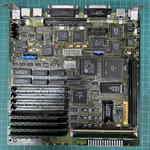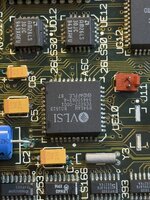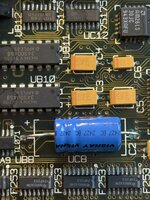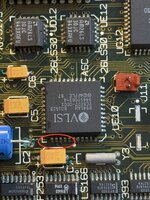jmacz
Well-known member
Pulling this into a separate thread for future search purposes.
I recently got a Macintosh SE/30 and have been working to get it back in working condition. This Mac did not have any battery bomb issues. The board was relatively clean. It had already been recapped before it came to me (tantalums for the SMDs and new axials). But the previous owner said the unit was not booting and was showing artifacts on the screen with no chime.
Initial Observations
There was a bodge wire from RP2 pin 12 to UE12 pin 18 that the person who recapped it had put in. Schematics show this connection is correct but I did not see any reason for this to be there. The trace on the motherboard between those two pins is intact and shows solid continuity with little resistance. So I removed it. Note that these two chips are part of the serial interface circuit and has nothing to do with the sound.
Second observation was markings on top of the UE10 chip. Clearly the person who recapped it was debugging a sound related issue as they have marked pin numbers on top of UE10.
Machine Configuration
At this point I should point out the machine configuration:
I have washed the motherboard in IPA. I have triple checked the solder joints on the 14 pin connector coming in from the analog board. All of the connections look good and strong, and the voltages look correct on the motherboard side of that connector.
Problem #1: Stuck on Gray Screen with No Chime - SOLVED
I could not reproduce the display artifacts but the machine would not chime and stayed stuck on the gray screen. This resolved itself after I pulled the ROM, cleaned it (and the socket) and reseated it.
Problem #2: Crashes on Welcome to Macintosh Screen - SOLVED
I was getting random crashes on the screen with the Welcome to Macintosh message. I pulled all the RAM modules and tested them in another working computer. Turned out one of them was bad. I replaced all four of the RAM modules with known working 1MB modules (for a total of 4MB of memory) and I was no longer seeing the crashes.
Problem #3: Low Volume Staticky Chime Followed by No Sound - OPEN ISSUE
When powered on, you hear a faint, slightly distorted, staticky boot chime which quickly fades in volume to no sound. Booting into System 6.0.8 using either a floppy or external SCSI device, I can go into the Sound control panel and playing with the volume slider, there's no sound at all. The only sound that plays is again the low volume boot chime but no sound after that.
I have tried using a pair of headphones via the headphone jack. Plugging the headset in, the sound is properly routed from the speaker to the headphone jack but I still get the same faint, distorted, staticky boot chime followed by no sound after that. I have tested the headphones and the speaker with a different SE/30 motherboard and they work fine. The issue is somewhere on the motherboard. If I move the problematic motherboard to another machine (speaker, analog board, PSU), same sound issue. So the problem moves with the motherboard.
Strange Observation: normally when you play with the Sound Control Panel, you see the menu bar flicker (black/white) if you turn the volume down to zero. But at any other setting, the beep noise will play at the selected volume level. This is true whether you have a speaker plugged in or not. I tested this with a couple other Macs (albeit not another SE/30). BUT, on my SE/30, it doesn't matter whether you select no volume or any of the volume levels, the menu bar flickers as if you selected the no volume option. So clearly the System is detecting something going on with the sound hardware.
The sound circuit is here outlined in red:

I have pulled the C2 capacitor (which was new) and tested it. Both resistance and capacitance were good. The Y3 Crystal looks ok as well. I have also pulled the new tantalum capacitors that are part of the sound circuit (C3, C4, C5, C6) and tested them. They are also good and have the correct values (47uF on C3/C4/C5, and 1uF on C6).
I checked Q1 and Q2, both seemed ok. I pulled UA9 checked underneath and it was also good. The usual problem with pin 7 (12V) and pin 14 (-12V) being broken were not a problem on this machine. Connectivity to all the ICs in this circuit on all pins checked out, I went through beeping each one using an SE/30 schematic I found online. Visually I see no broken traces on the top side or the bottom side of the board. I have also continuity tested all the SMD resistors and capacitors on the bottom of the board (that are part of the sound circuit), and those seemed ok. Resistance values checked out on the resistors.
I have also checked the voltages coming into the sound circuit, namely +5V, +12V, and -12V. Those all look good at the pins on the ICs that expect them.
Next step: I'm in the process of pulling the three remaining chips I haven't touched yet, the two Sony branded sound chips (UB10 and UB11), as well as UE10. If everything looks good underneath as well as with each pin, then I'm going to stick some scope probes on the sound generation path and see if I can follow back from the speaker to where the sound signal disappears. Hopefully the issue isn't inside one of these ICs as then it's hopeless without a donor board.
Problem #4: Freeze on Boot on System 7+
Booting with System 6.0.8 whether via floppy or via external SCSI works fine. It's surprisingly fast (time from gray screen to desktop is like 3-5 seconds?).
But booting with System 7 or higher causes a freeze post the "Welcome to Macintosh" screen. When these freezes happen, the mouse cursor still can be moved, but the machine makes no further progress on boot even after 15 minutes. Under System 7.1.1, this freeze occurs right before it gets to the Finder on the gray screen after extensions load. Under System 7.5.5, this freeze occurs right after the "smiley mac" screen appears (after the Welcome to Macintosh screen) before any extension icons have appeared on the screen. In both cases, disabling extensions does not help. This occurs on Floppy or on SCSI. Doesn't make a difference.
It appears the newer OS might be exposing/triggering something wrong with the hardware whereas System 6.0.8 does not.
Haven't made much progress on this one because I've been focused on the sound issue which seems to be smaller in scope, hoping that a fix there might also resolve this issue and be related.
Pictures of the Motherboard
Please ignore the "weirdness" on the bottom of the board near where the Sony sound chips should be. The picture was taken while I was in the middle of removing the Sony sound chips. I had to pause as my desoldering gun got clogged.


If anyone has any suggestions, would appreciate it.
FYI that as I mentioned, I'm in the processing removing the remaining sound circuit ICs to clean them / check underneath. I have also since decapped all the new capacitors, checked each individually, and placed them back on the board.
I recently got a Macintosh SE/30 and have been working to get it back in working condition. This Mac did not have any battery bomb issues. The board was relatively clean. It had already been recapped before it came to me (tantalums for the SMDs and new axials). But the previous owner said the unit was not booting and was showing artifacts on the screen with no chime.
Initial Observations
There was a bodge wire from RP2 pin 12 to UE12 pin 18 that the person who recapped it had put in. Schematics show this connection is correct but I did not see any reason for this to be there. The trace on the motherboard between those two pins is intact and shows solid continuity with little resistance. So I removed it. Note that these two chips are part of the serial interface circuit and has nothing to do with the sound.
Second observation was markings on top of the UE10 chip. Clearly the person who recapped it was debugging a sound related issue as they have marked pin numbers on top of UE10.
Machine Configuration
At this point I should point out the machine configuration:
- Macintosh SE/30 motherboard revision 820-0260-A
- 4MB of total memory using four 1MB simms populating 4 of the 8 slots
- Analog board and PSU recapped by me, both work fine when used with another machine and generates proper voltages
- FDHD floppy drive
- ZuluSCSI mini attached to the external SCSI connector (also tested a ZuluSCSI RP2040 connected to the internal SCSI connector)
- No PRAM battery installed currently
- ADB mouse and keyboard connected
I have washed the motherboard in IPA. I have triple checked the solder joints on the 14 pin connector coming in from the analog board. All of the connections look good and strong, and the voltages look correct on the motherboard side of that connector.
Problem #1: Stuck on Gray Screen with No Chime - SOLVED
I could not reproduce the display artifacts but the machine would not chime and stayed stuck on the gray screen. This resolved itself after I pulled the ROM, cleaned it (and the socket) and reseated it.
Problem #2: Crashes on Welcome to Macintosh Screen - SOLVED
I was getting random crashes on the screen with the Welcome to Macintosh message. I pulled all the RAM modules and tested them in another working computer. Turned out one of them was bad. I replaced all four of the RAM modules with known working 1MB modules (for a total of 4MB of memory) and I was no longer seeing the crashes.
Problem #3: Low Volume Staticky Chime Followed by No Sound - OPEN ISSUE
When powered on, you hear a faint, slightly distorted, staticky boot chime which quickly fades in volume to no sound. Booting into System 6.0.8 using either a floppy or external SCSI device, I can go into the Sound control panel and playing with the volume slider, there's no sound at all. The only sound that plays is again the low volume boot chime but no sound after that.
I have tried using a pair of headphones via the headphone jack. Plugging the headset in, the sound is properly routed from the speaker to the headphone jack but I still get the same faint, distorted, staticky boot chime followed by no sound after that. I have tested the headphones and the speaker with a different SE/30 motherboard and they work fine. The issue is somewhere on the motherboard. If I move the problematic motherboard to another machine (speaker, analog board, PSU), same sound issue. So the problem moves with the motherboard.
Strange Observation: normally when you play with the Sound Control Panel, you see the menu bar flicker (black/white) if you turn the volume down to zero. But at any other setting, the beep noise will play at the selected volume level. This is true whether you have a speaker plugged in or not. I tested this with a couple other Macs (albeit not another SE/30). BUT, on my SE/30, it doesn't matter whether you select no volume or any of the volume levels, the menu bar flickers as if you selected the no volume option. So clearly the System is detecting something going on with the sound hardware.
The sound circuit is here outlined in red:

I have pulled the C2 capacitor (which was new) and tested it. Both resistance and capacitance were good. The Y3 Crystal looks ok as well. I have also pulled the new tantalum capacitors that are part of the sound circuit (C3, C4, C5, C6) and tested them. They are also good and have the correct values (47uF on C3/C4/C5, and 1uF on C6).
I checked Q1 and Q2, both seemed ok. I pulled UA9 checked underneath and it was also good. The usual problem with pin 7 (12V) and pin 14 (-12V) being broken were not a problem on this machine. Connectivity to all the ICs in this circuit on all pins checked out, I went through beeping each one using an SE/30 schematic I found online. Visually I see no broken traces on the top side or the bottom side of the board. I have also continuity tested all the SMD resistors and capacitors on the bottom of the board (that are part of the sound circuit), and those seemed ok. Resistance values checked out on the resistors.
I have also checked the voltages coming into the sound circuit, namely +5V, +12V, and -12V. Those all look good at the pins on the ICs that expect them.
Next step: I'm in the process of pulling the three remaining chips I haven't touched yet, the two Sony branded sound chips (UB10 and UB11), as well as UE10. If everything looks good underneath as well as with each pin, then I'm going to stick some scope probes on the sound generation path and see if I can follow back from the speaker to where the sound signal disappears. Hopefully the issue isn't inside one of these ICs as then it's hopeless without a donor board.
Problem #4: Freeze on Boot on System 7+
Booting with System 6.0.8 whether via floppy or via external SCSI works fine. It's surprisingly fast (time from gray screen to desktop is like 3-5 seconds?).
But booting with System 7 or higher causes a freeze post the "Welcome to Macintosh" screen. When these freezes happen, the mouse cursor still can be moved, but the machine makes no further progress on boot even after 15 minutes. Under System 7.1.1, this freeze occurs right before it gets to the Finder on the gray screen after extensions load. Under System 7.5.5, this freeze occurs right after the "smiley mac" screen appears (after the Welcome to Macintosh screen) before any extension icons have appeared on the screen. In both cases, disabling extensions does not help. This occurs on Floppy or on SCSI. Doesn't make a difference.
It appears the newer OS might be exposing/triggering something wrong with the hardware whereas System 6.0.8 does not.
Haven't made much progress on this one because I've been focused on the sound issue which seems to be smaller in scope, hoping that a fix there might also resolve this issue and be related.
Pictures of the Motherboard
Please ignore the "weirdness" on the bottom of the board near where the Sony sound chips should be. The picture was taken while I was in the middle of removing the Sony sound chips. I had to pause as my desoldering gun got clogged.


If anyone has any suggestions, would appreciate it.
FYI that as I mentioned, I'm in the processing removing the remaining sound circuit ICs to clean them / check underneath. I have also since decapped all the new capacitors, checked each individually, and placed them back on the board.




